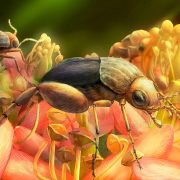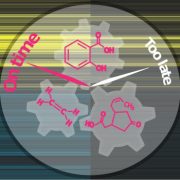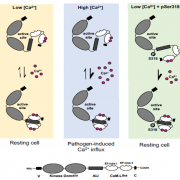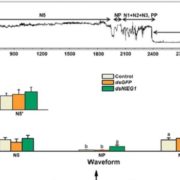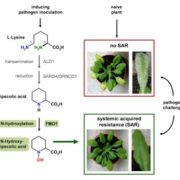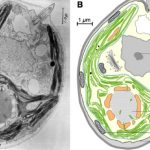Pipecolic contributes to systemic acquired resistance in barley ($) (MPMI)
Systemic acquired resistance (SAR) is a robust long-distance immune response mediated by a diverse contingent of candidate phloem-mobile signals that prime distal uninfected tissues for enhanced resistance to future infections. The lysine-derived catabolite pipecolic acid (Pip) has emerged as a key mediator of SAR in dicot model species like Arabidopsis, however comparatively less is known of its role in monocots. In a new article, Lenk et al. explore the contribution of Pip to SAR in the model monocot crop Hordeum vulgare (barley). The authors demonstrate that phloem sap-enriched exudates collected from barley leaves infected with the bacterial pathogen Pseudomonas syringae pv. japonica (Psj) accumulate high levels of Pip relative to mock-treated controls. Importantly, exudates collected from Psj-infected barley leaves activate SAR-marker gene expression (AtPR1; Pathogenesis-related1) and provide enhanced resistance to P. syringae pv. tomato (Pst) when exudates were exogenously applied to leaves of Arabidopsis thaliana. A conserved role for Pip in mediating SAR in barley was further supported through Pip-irrigation experiments, where barley plants irrigated with Pip exhibited enhanced resistance to hemi-biotrophic bacterial (Xanthomonas translucens pv. cerealis) and fungal (Blumeria graminis f. sp. hordei) infections compared to control-treated plants. Conversely, pathogen- or Pip-induced systemic immunity was not achieved against the necrotrophic pathogen Pyrenaphore teres, suggesting a specific contribution of Pip to resistance against pathogenic microbes with a biotrophic infection phase. Additional mechanistic analyses identified that Pip-treatment led to the accumulation of nitric oxide in barley leaves, similar to observations from model dicots. Nitric oxide formation in barley leaves was associated with the priming of reactive oxygen species (ROS) accumulation, such that Pip-treated plants exhibited stronger superoxide anion accumulation relative to mock-treated controls when infected with Xanthomonas as revealed by histochemical NBT (nitroblue tetrazolium) staining. Collectively, this work extends mechanistic knowledge on Pip-mediated SAR to economically important crops and identifies it as a potent activator of disease resistance in cereals. (Summary by Phil Carella) MPMI 10.1094/MPMI-01-19-0013-R


